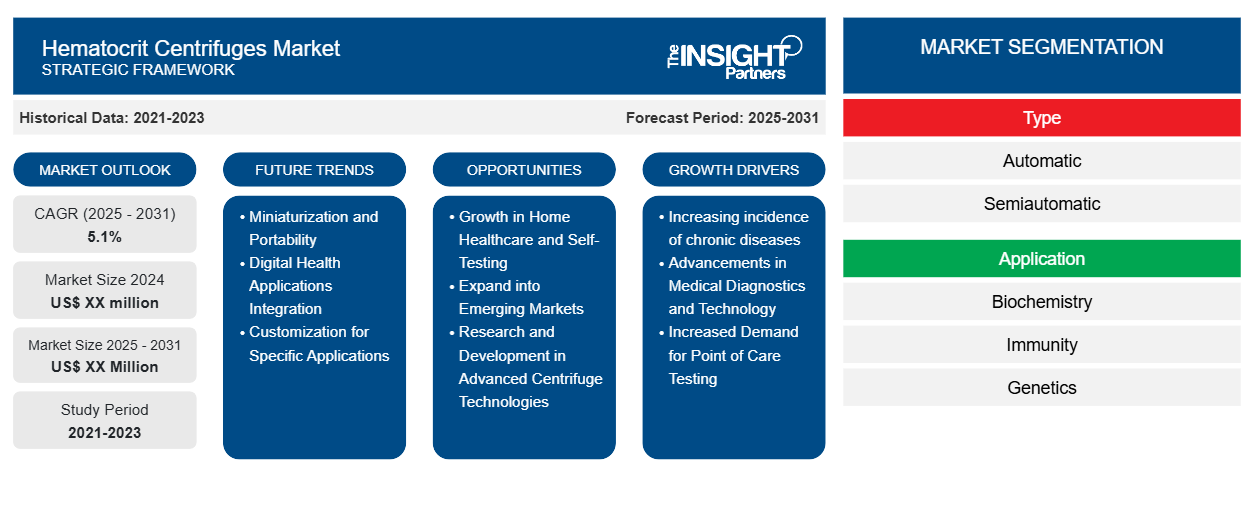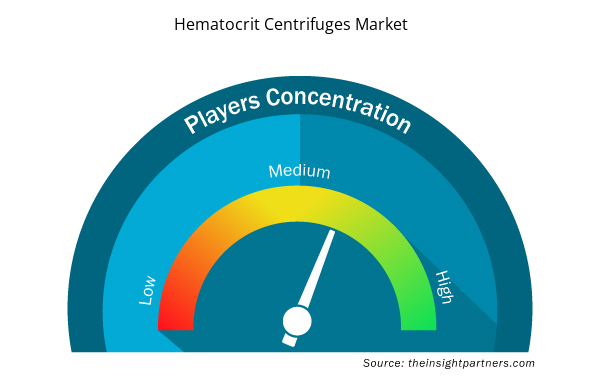The Hematocrit Centrifuges Market is expected to register a CAGR of 5.1% from 2025 to 2031, with a market size expanding from US$ XX million in 2024 to US$ XX Million by 2031.
The report is segmented by Type (Automatic, Semiautomatic). The report is segmented by Application (Biochemistry, Immunity, Genetics, Other). The global analysis is further broken-down at regional level and major countries. The Report Offers the Value in USD for the above analysis and segments.
Purpose of the Report
The report Hematocrit Centrifuges Market by The Insight Partners aims to describe the present landscape and future growth, top driving factors, challenges, and opportunities. This will provide insights to various business stakeholders, such as:
- Technology Providers/Manufacturers: To understand the evolving market dynamics and know the potential growth opportunities, enabling them to make informed strategic decisions.
- Investors: To conduct a comprehensive trend analysis regarding the market growth rate, market financial projections, and opportunities that exist across the value chain.
- Regulatory bodies: To regulate policies and police activities in the market with the aim of minimizing abuse, preserving investor trust and confidence, and upholding the integrity and stability of the market.
Hematocrit Centrifuges Market Segmentation
Type
- Automatic
- Semiautomatic
Application
- Biochemistry
- Immunity
- Genetics
- Other
Customize This Report To Suit Your Requirement
You will get customization on any report - free of charge - including parts of this report, or country-level analysis, Excel Data pack, as well as avail great offers and discounts for start-ups & universities
Hematocrit Centrifuges Market: Strategic Insights

- Get Top Key Market Trends of this report.This FREE sample will include data analysis, ranging from market trends to estimates and forecasts.
Hematocrit Centrifuges Market Growth Drivers
- Increasing incidence of chronic diseases: The epidemiological burden of chronic diseases, like diabetes, cardiovascular diseases, and kidney ailments, is constantly increasing on a global scale, which has become an important growth driver for the hematocrit centrifuge market. Most chronic diseases tend to affect blood and red blood cell count; hence, regular testing to monitor the conditions of the patients may be required. On increasing blood tests for diagnosis and monitoring, hematocrit centrifuges become most essential instruments to separate whole blood components and facilitate an accurate assessment regarding these inflicted conditions.
- Advancements in Medical Diagnostics and Technology: Technological advancements in medical devices like hematocrit centrifuges are greatly contributing toward uplifted growth of the market. The centrifuges are much more automated, compact, and energy efficient at present than traditional centrifuges. Automated operations allow for greater throughput and less human error, which increases laboratory efficiency and accuracy. Also, the integration of the devices with Laboratory Information Management Systems (LIMS) helped simplify data management critical in diagnostics.
- Increased Demand for Point of Care Testing: There is a clear shift towards point of care testing such that it will change the face of healthcare services. The urgent and precise diagnostic need, especially in rural and underserved areas, is increasing. Hematocrit centrifuges are in a very hot demand; used for portable or compact use cases in point-of-care installations; their opening is broadening up space for more manufacturers to innovate and meet that growing part of the marketplace. Most recently, hematocrit tests are done outside of the traditional laboratory setting, which helps promote the use of such devices.
Hematocrit Centrifuges Market Future Trends
- Miniaturization and Portability: This is the main trend in the hematocrit centrifuge market: miniaturization of devices. There has been an increase in the development of portable and compact centrifuges that can be used in a variety of environments, such as small clinics, physician offices, and home healthcare settings. They are also light in weight and easy to operate with little amount of storage space requirement; hence, ideal for use in restricted environments. The trend is mostly indicated in point-of-care testing and remote diagnostics.
- Digital Health Applications Integration: Hematocrit centrifuges exemplify this vein-integration, medical devices into the repertoire of digital health platforms. With telemedicine and remote health monitoring, hematocrit centrifuges are likely to be interfaced with cloud-based systems or digital health platforms. Through these centrifuges, data generated can, in real-time, be sent to healthcare providers to ease quick decision-making regarding the patient's health.
- Customization for Specific Applications: Yet another emerging trend in hematocrit centrifuges is their manufacture for particular indications. Manufacturers are focusing on developing hematocrit centrifuges for certain patient groups or specific test requirements. There is a trend toward products that have been optimized for blood testing: in pediatrics or newborns, or for the processing of large-batch blood samples. Such centrifuges are very slowly penetrating hospitals and specialized laboratories that will require those exceptional instruments.
Hematocrit Centrifuges Market Opportunities
- Growth in Home Healthcare and Self-Testing: With the growing awareness of healthcare, it is evident that more people are moving into home healthcare and self-testing facilities. Hematocrit testing has left the borders of clinical laboratories, with more patients being able to conduct the testing at home, facilitated by small and easy-to-use devices. Thus, there exists a lucrative market for home-based hematocrit centrifuges, which may be a good opportunity for manufacturers of devices that could be easily used and transported, being bought by the consumer needing regular monitoring of health.
- Expand into Emerging Markets: The emerging economies of Asia-Pacific, Latin America, and Africa aside, there remains plenty of space where hematocrit centrifuge makers can establish themselves. Such continents were characterized by fast-growing economies and increasing investments in health care, accompanied by a stronger drive towards access to health care. The same trend is slowly emerging in other areas of demand for diagnostic testing, which open up new avenues for manufacturers by way of cost-effective, efficient, and highly adaptable models of centrifuges to fit into such markets conveniently.
- Research and Development in Advanced Centrifuge Technologies: New opportunities in innovation are opened by the continuing research and development (R&D) efforts aimed at improving performance and functionality of hematocrit centrifuges. R&D in such areas as automations, higher efficiency, low noise, and compatibility with diagnostic kits or other analytical instruments will ultimately help manufacturers in producing advanced products. In addition, the integration of artificial intelligence (AI) and machine learning for smarter operation and predictive analytics could unlock new potentials in the market.
Hematocrit Centrifuges Market Regional Insights
The regional trends and factors influencing the Hematocrit Centrifuges Market throughout the forecast period have been thoroughly explained by the analysts at Insight Partners. This section also discusses Hematocrit Centrifuges Market segments and geography across North America, Europe, Asia Pacific, Middle East and Africa, and South and Central America.

- Get the Regional Specific Data for Hematocrit Centrifuges Market
Hematocrit Centrifuges Market Report Scope
| Report Attribute | Details |
|---|---|
| Market size in 2024 | US$ XX million |
| Market Size by 2031 | US$ XX Million |
| Global CAGR (2025 - 2031) | 5.1% |
| Historical Data | 2021-2023 |
| Forecast period | 2025-2031 |
| Segments Covered |
By Type
|
| Regions and Countries Covered | North America
|
| Market leaders and key company profiles |
Hematocrit Centrifuges Market Players Density: Understanding Its Impact on Business Dynamics
The Hematocrit Centrifuges Market market is growing rapidly, driven by increasing end-user demand due to factors such as evolving consumer preferences, technological advancements, and greater awareness of the product's benefits. As demand rises, businesses are expanding their offerings, innovating to meet consumer needs, and capitalizing on emerging trends, which further fuels market growth.
Market players density refers to the distribution of firms or companies operating within a particular market or industry. It indicates how many competitors (market players) are present in a given market space relative to its size or total market value.
Major Companies operating in the Hematocrit Centrifuges Market are:
- Scilogex
- Horiba
- Beckman Coulter
- Thermo Scientific
- Benchmark Scientific
Disclaimer: The companies listed above are not ranked in any particular order.

- Get the Hematocrit Centrifuges Market top key players overview
Key Selling Points
- Comprehensive Coverage: The report comprehensively covers the analysis of products, services, types, and end users of the Hematocrit Centrifuges Market, providing a holistic landscape.
- Expert Analysis: The report is compiled based on the in-depth understanding of industry experts and analysts.
- Up-to-date Information: The report assures business relevance due to its coverage of recent information and data trends.
- Customization Options: This report can be customized to cater to specific client requirements and suit the business strategies aptly.
The research report on the Hematocrit Centrifuges Market can, therefore, help spearhead the trail of decoding and understanding the industry scenario and growth prospects. Although there can be a few valid concerns, the overall benefits of this report tend to outweigh the disadvantages.
- Historical Analysis (2 Years), Base Year, Forecast (7 Years) with CAGR
- PEST and SWOT Analysis
- Market Size Value / Volume - Global, Regional, Country
- Industry and Competitive Landscape
- Excel Dataset



Report Coverage
Revenue forecast, Company Analysis, Industry landscape, Growth factors, and Trends

Segment Covered
This text is related
to segments covered.

Regional Scope
North America, Europe, Asia Pacific, Middle East & Africa, South & Central America

Country Scope
This text is related
to country scope.
Frequently Asked Questions
Automatic segment, by Type, dominated the market in 2023.
North America region dominated the Hematocrit Centrifuges market in 2023.
Growth in Home Healthcare and Self-Testing growth act as a opportunity for growth of the market in forecast period.
The Hematocrit Centrifuges Market is estimated to witness a CAGR of 5.1% from 2023 to 2031
The major factors driving the Hematocrit Centrifuges market are:
1. Increasing incidence of chronic diseases
2. Advancements in Medical Diagnostics and Technology
Players operating in the market are Scilogex, Horiba, Beckman Coulter, Thermo Scientific, Benchmark Scientific, AHN Biotechnologie, DLAB Scientific Co., Ltd., Daigger Scientific, Inc, Hunan Kecheng Instrument and Equipment, Andreas HETTICH GmbH & Co.KG
Trends and growth analysis reports related to Life Sciences : READ MORE..
1. Scilogex
2. Horiba
3. Beckman Coulter
4. Thermo Scientific
5. Benchmark Scientific
6. AHN Biotechnologie
7. DLAB Scientific Co., Ltd.
8. Daigger Scientific, Inc
9. Hunan Kecheng Instrument and Equipment
10. Andreas HETTICH GmbH and Co.KG

 Get Free Sample For
Get Free Sample For